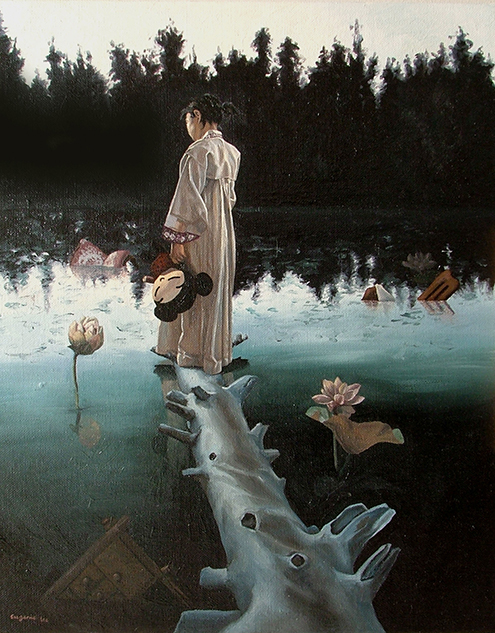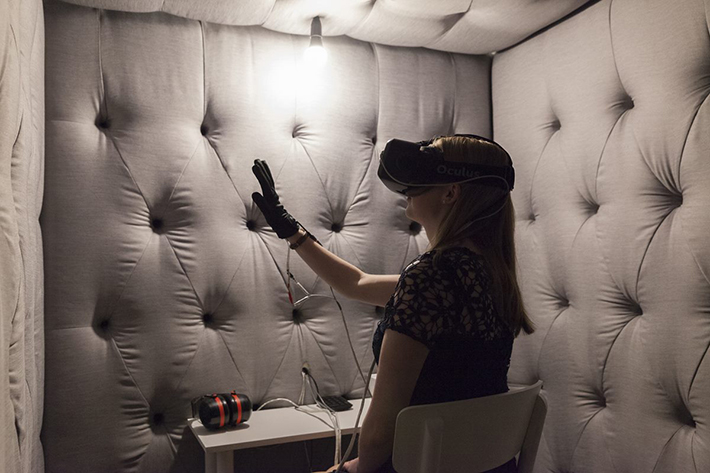In this interview, WWDA staff member Mali Hermans spoke with Korean-Australian interdisciplinary artist Eugenie Lee, learning more about her creative practice as a disabled woman.
In the lead up to the WWDA LEAD Art Prize Exhibition, this interview is the first in a series highlighting the art of disabled women and non-binary people across Australia. The WWDA LEAD Art Prize is open for submissions until 23 July 2021.
***
Mali Hermans (MH): First, can you tell me a bit about who you are and your work?
Eugenie Lee (EL): I live on the land of the Wangal clan, what others also call Canada Bay in Sydney. I am a Sydney-based, Korean-Australian interdisciplinary artist with a conceptual focus on my lived experience with persistent pain. Experimentation and collaboration with pain scientists and researchers, who investigate ways in which technologies can assist in pain research, are an important conceptual underpinning for my interdisciplinary art practice which includes participatory performances using technologies, installations, sculptures and paintings.

Let me be a wildflower
2005
30 x 44 cm
Oil on linen
Image credit: Eugenie Lee
MH: When did you first start making art? Why is art an important medium for you?
EL: My creative works, started primarily with painting, and the concept of pain started with my own lived experience with endometriosis and adenomyosis since 2000. Pain was affecting my life more than any other symptoms of living with this condition, but I didn’t know anything about chronic pain back then.
No one had told me that the experience of loneliness, isolation, loss of identity, existential crisis, sense of worth, and helplessness was a part of a natural pain experience. I had always thought that pain was a biomechanical thing that was only related to endometrial tissues which could be surgically removed and therefore all the pain would go away, and this idea was consistently suggested by all the clinicians I have seen until recently.
So, the way I was painting was a means to express all my confusing experiences I couldn’t talk about with anybody. I had somehow thought that these psychosocial experiences were wrong yet so real to me. But I gradually began to have more confidence in my own experiences, and eventually started to find my identity as a woman with an invisible disability. Although it has taken many years to do this, the challenge of building a career as an artist whilst living with a long-term invisible disability has become a defining motivation for my art practice.
Although I began with paintings as my primary medium, I am now very much interested in using creative technologies through performance installation to convey the concept of pain in my work.
A real turning point was in 2014 when I received an art residency from Accessible Arts Australia to work with neuroscientists focusing on chronic pain research at Body In Mind, based at UniSA, and Neuroscience Research Australia; and subsequently through the Synapse Residency by Australian Network for Art & technology (ANAT) that allowed me to continue working with them for 2 years. We collaborated to create an ambitious artwork together and the resulting work became a participatory installation performance using Virtual Reality and a custom-built haptic wearable device for the participating audience to undergo a perception of pain experience.
I find this medium closer for me to connect with the audience as it involves one-on-one interaction in close proximity, and my performance can also be adaptable depending on the audience’s needs.
Seeing Is Believing 2016 – 2019
Participatory performance installation, UNSW Galleries, UNSW Art & Design
Virtual Reality, Mediated Reality, Custom-built gloves, subwoofer speakers, mid-frequency speakers, acoustic foam, fabric, MDF, light bulb, desk, chairs
Participant: Dr Hayley Thair
Image credit: Silversalt photography

MH: Do you think your experiences of disability provide you with a particular lens or insight that non-disabled artists don’t have?
EL: Absolutely. Nothing can replace the lived experience and the insight gained from this. The deep understanding of our own lived experience has the power to reach and connect with others that no amount of academic or any other research can ever provide.
MH: Are there other experiences, whether they be of race, of gender, of class, that influence your work? How do these experiences interact with disability for you?
EL: I was born in South Korea which is still very much a patriarchal society. Growing up in those cultural norms which enforces unnecessary barriers for girls, I had internalised limitations as a part of my identity into my adulthood. Since moving to Australia, notwithstanding there still is long way to go in terms of gender equality, I began to shed some of these ludicrous constrains. I now call myself a proud feminist, and I include my feminist perspective into my artmaking particularly within the concept of pelvic pain.
Pelvic pain is often dismissed as being a “women’s issue” and “too complex”, despite being a common issue for both genders and all ages. I often create artworks to shine a light on the social attitudes and stigma that silence people living with pelvic pain, by making just a little of what goes on behind closed doors shareable in a way that presents a confronting topic through an engaging medium.
MH: Can you share with us a piece of creative work you’re really proud of?
EL: My work Breakout My Pelvic Sorcery (work in progress 2019 -), a Virtual Reality art/science/technology collaborative project about persistent pelvic pain diseases. It can be viewed here.
MH: What needs to change in the creative world for disabled artists? What does access done well look like?
EL: More opportunities are needed for disabled artists to not only exhibit, but for grant funding support. The exhibition venues and funding bodies also need to be better equipped at listening and being flexible towards disabled artists’ access needs.
MH: Finally, what is one piece of advice or encouragement every disabled artist should hear?
EL: Our voice matters, so speak up through any means you know best!
